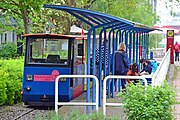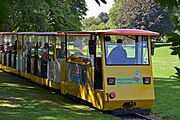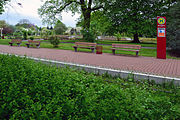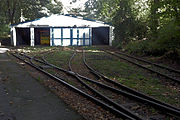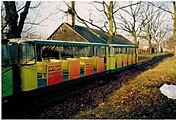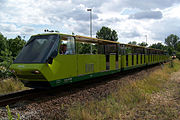Grugabahn
| Grugabahn | |||||||||||||||||||||||||||||||||||||||||||||||||
|---|---|---|---|---|---|---|---|---|---|---|---|---|---|---|---|---|---|---|---|---|---|---|---|---|---|---|---|---|---|---|---|---|---|---|---|---|---|---|---|---|---|---|---|---|---|---|---|---|---|
|
Grugabahn train "Secret love"
| |||||||||||||||||||||||||||||||||||||||||||||||||
| Route length: | 3.3 km | ||||||||||||||||||||||||||||||||||||||||||||||||
| Gauge : | 600 mm ( narrow gauge ) | ||||||||||||||||||||||||||||||||||||||||||||||||
| Top speed: | 20 km / h | ||||||||||||||||||||||||||||||||||||||||||||||||
|
|||||||||||||||||||||||||||||||||||||||||||||||||
The Grugabahn is a park railway in the Grugapark in Essen . It has its origins in a steam-powered Liliput train from 1938.
Grugabahn today
The train runs over a distance of around 3.3 kilometers. The circuit has the shape of a wide, looped figure eight and thus reaches the entire complex of the Grugapark. Today 's trains, which are electrically operated with accumulators and offer around 90 seats, have been running since 1997 and traditionally have the old names Angry Ant , Secret Love , Vigilant Chicken , Black Lene and Hard-Working Lieschen . The trains initially had a white color scheme and were given their current colorful appearance in the mid-2000s. They are parked and serviced in a five-hour depot in the park near the maze. The railway has been operated by the Intamin company since 1992 . One year later, the city of Essen acquired the entire facility, and the train operations are still managed by Intamin.
Stops / train stations
There are three stops in the park where you can get on and off
- Orangery
- Model gardens
- Tummelwiese
These are close to the larger park entrances.
Traditional Essen train names
The trains of the Grugabahn traditionally have names related to the city of Essen and the park:
- Angry Ant: Restaurant in the Ruhr Valley in Bergerhausen at the end of Ruhrallee, named after the nickname of a busy but irritable landlady,
- Secret love: excursion restaurant on the street Baldeney, mentioned as early as 1853, north over the Baldeneysee ,
- Watchful cockerel : In the Middle Ages it became a symbol of the city, to this day a symbol of the Essen rifle clubs, a monument from 1930 with the golden cock on a stele is on Kardinal-Hengsbach-Platz, formerly Kurienplatz.
- Schwarze Lene: today the name of an excursion restaurant in the Schellenberg Forest above the Baldeneysee; Anna Magdalena Bramkamp b. Plückthun (born October 14, 1777 in Bredeney ; † May 17, 1857 ibid) was the landlady of a summer tavern that was visited by the Trample Club. This club was a notable walking club in Essen, in which, among others, Alfried Krupp and Adolf Knaudt were members. The landlady received the nickname Black Lene because of her black hair.
- Hard-working Lieschen: Cultivated plant from the genus of spring herbs , metaphor for the horticultural exhibition itself.
history
Reich Garden Show 1938
At the 1938 Reichsgartenschau, a steam-powered Liliput train from Erich Brangsch GmbH Klein- und Feldbahnen ( Leipzig-Engelsdorf ) went into operation for the first time on the site of today's Grugapark. At the same time, the Brangsch company was responsible for the vehicles and the route. The trains were named Angry Ant and Black Lene , Vigilant Chicken and Big Bertha , each of which consisted of a miniature steam locomotive with a tender and five roofed, four-axle observation cars. This small exhibition railway with a track width of 381 mm was destroyed in World War II.
post war period
After the war, a steam-powered field railway with a 600 mm gauge was installed to rebuild the devastated park, which from 1949 also carried people through the site again. At first there was only one train. This was then replaced by two diesel-powered vehicles called Vigilant Chicken and Busy Lieschen . There was also a battery-powered locomotive called Tuttmanns Esel . The name goes back to the Tuttman family in Essen, who owned a farm in Stoppenberg that burned down in 1895 and was demolished.
In addition, a Hilda steam locomotive from the Arnold Jung locomotive factory ran from September 1949 . It had a length without buffers of 4.66 meters, a width of 1.93 meters and a height of 2.72 meters. With a weight of 11.9 tons and 75 hp, it reached a top speed of 20 km / h and could negotiate a curve radius of 15 meters.
For the second Gruga exhibition in 1952, two more diesel locomotives were added, so that the battery and steam locomotives were subsequently decommissioned.
The operator of the railway on behalf of the Grugaparkverwaltung was the Essen tram , at that time under the umbrella of the Süddeutsche Eisenbahn-Gesellschaft (SEG). Since 1954, the former SEG traded under the name of Essener Verkehrs-AG (EVAG), which did not change the operational management.
Vehicles and whereabouts
The diesel locomotives came from Demag (type ML50, type B-dm). In addition to the cars manufactured in the workshop of the Essen tram under the direction of SEG, they also pulled Péchot cars from an army field railway. These wagons were named after Colonel Prosper Péchot, who adapted numerous military bodies for French light railways.
When the Grugapark closed for two years in 1963 due to extensive construction work until the opening of the Federal Horticultural Show in 1965, the diesel trains were taken out of service.
A locomotive built in around 1942, the first still trains for clearing rubble and later the Watchful chicken park train pulled mentioned, is now in Münsterländische Feldbahnmuseum in Rheine . In 1957, she worked for a building contractor in Essen, and in 1965 she went to a scrap shop on Eisenbahnstrasse in Essen-Rellinghausen , before being set up on a playground on Steinplatz in Essen's southern district around 1980 . The locomotive finally came to the Feldbahnmuseum in 1992. Another such locomotive pulled the train “ Busy Lieschen” and went to the Arbeitsgemeinschaft Muttenthalbahn eV in 1999 via a playground in Essen-Frohnhausen , a scrap dealer in Gevelsberg . V. in Witten and from its mine and field railway museum Zeche Theresia 2014 on loan to Ilmenau in Thuringia for 20 years. The third locomotive, whose whereabouts are unclear, pulled the train Angry Ant .
Federal Garden Show 1965
Since the expansion of the park area for the Federal Garden Show in 1965 from 47 hectares to 70 hectares, the railway has operated on a 3.5 kilometer long circuit on a 600 mm track. With the extended route, the southern part of the park between Lührmannstrasse and the Grugabad was redeveloped. The operator was still the Essener Verkehrs-AG.
vehicles
For the Federal Garden Show, uniformly streamlined multiple units in a contemporary design with Opel-Kapitän engines converted to gas operation were purchased. The concept of the equally modern trains on a 600 mm track had previously proven itself on the park railway at the 1959 Federal Horticultural Show in Dortmund. The five Essen one-way trains with a powered end car plus wagons were from the Bücking & Rappold company in Essen- Altendorf and were called Angry Ant , Secret Love , Vigilant Chicken , Black Lene and Hard-working Lieschen . In addition, there was a sixth powered end car called Gruga as a reserve .
During the tour, the passengers were given information about sights and the history of the park from the tape.
Whereabouts
Due to the transfer of operations to the Intamin company and the conversion of the Grugabahn to electrical operation in 1991, the gas trains left Essen: two power cars and five sidecars went to the Cottbus Park Railway for the 1995 Federal Horticultural Show . This train set has been completely overhauled and has been running there with new VW engines since 1995. Another powered end car and a sidecar have been in use since 2003 at the Bebra Railway Friends , known there as the beaver lightning bolt . Another sidecar was scrapped in Bebra, a third handed over to Halle. Another train, last used in Grugapark for special trips as a wedding express, was parked for a long time at Zeche Zollern II / IV in Dortmund-Bövinghausen . In the meantime it has been handed over to the Peißnitzexpress Halle (Saale) park railway , where it is to be processed. A sidecar has also been in use there since 2015, which was taken over from Bebra. Two sidecars were temporarily located at the Bad Schwalbacher Kurbahn and from there came into the possession of the field and mine railway museum of the Fortuna visitor mine in Solms - Oberbiel .
"Parkbahn-ICE" in Cottbus
Gas train at Zeche Zollern 2013, since 2016 Park Railway Peißnitzexpress Halle (Saale)
Stops
The two stops at the main station Kranichwiese and Tummelwiese (formerly Kleintiergarten , formerly Grugabad ) already existed as train stations (each with two tracks) at the time of EVAG operations, with Grugabad train station being passed through most of the time without stopping. Entry to the tour was only possible at the main train station . After the takeover by the Intamin company, the first stop was the roller skating rink / country house near the roller skating rink entrance . After the use of this entrance was restricted in 2008 for season ticket holders only and a new entrance was opened at the new model garden, a new stop was created near it. This resulted in the abandonment of the roller-skating rink stop , the platform itself remained without furniture for a long time, but was dismantled in winter 2015/16. Since the 2015 season, the Kranichwiese station is no longer served. Instead, the stop of the same name was built near the park entrance at the orangery .
In the area of the main train station , the track systems were moved further into the park in the course of a trade fair expansion through the construction of Hall 3, which resulted in the current route and length. The station lost its second platform track, but a siding was created north of the platform. Before the 2016 season, the track in the area of the current exhibition hall 8 was relocated five meters north into the park in order to make room for the upcoming exhibition expansion.
Depots
The depot was relocated from the location west of the crane meadow near the maze. The sidings of the old depot have been partially covered with a layer of asphalt. The old depot hall has other uses today.
Web links
- Official presentation of the Grugabahn , Grugapark
- Entry on Gruga-Bahn in the " KuLaDig " database of the Rhineland Regional Association
- Entry on the older route of the Gruga railway in the " KuLaDig " database of the Rhineland Regional Council
- private website with many photos of the throttle cables
literature
- Martin Raddatz: The Grugapark in Essen and its field railways , in: ArGe Drehscheibe (ed.), Drehscheibe 218 (27th year, issue 6/09, September / October 2009), pp. 107–111
- Hans Ahlbrecht: "Park" and ride - the Grugabahn through the ages , in: Essener Verkehrs-AG (ed.), Hundred Years in Essen on Wire - The Tram, p. 146
Footnotes
- ↑ INTAMIN Bahnechnik & Betriebsgesellschaft mbH & Co. KG: Small Trains. (No longer available online.) Archived from the original on October 21, 2014 ; Retrieved May 5, 2015 . Info: The archive link was inserted automatically and has not yet been checked. Please check the original and archive link according to the instructions and then remove this notice.
- ^ Institute for Narrative Research in the Ruhr Area: A fabulous hike in Essen-Rellinghausen. Retrieved May 5, 2015 .
- ↑ DerWesten, FUNKE DIGITAL GmbH & Co. KG: “Heimliche Liebe” over the Baldeneysee reopens. July 19, 2014, accessed May 5, 2015 .
- ^ Erwin Dickhoff: Essener streets . Ed .: City of Essen - Historical Association for City and Monastery of Essen. Klartext-Verlag, Essen 2015, ISBN 978-3-8375-1231-1 , p. 300 .
- ↑ light railway vehicles and -exponate , Münsterländisches Feldbahnmuseum e. V., Rheine / Westphalia, accessed: December 15, 2018
- ↑ Barbara Zabka: “Lieschen” goes on a journey - the museum gives the locomotive on permanent loan , Ruhrnachrichten, March 11, 2014, accessed: December 15, 2018
- ↑ Parkeisenbahn Cottbus: Diesel multiple unit ICE 299 010/299 011 , accessed on March 10, 2016.
- ↑ Eisenbahnfreunde Bebra e. V .: Our vehicles , accessed on March 9, 2016.
- ↑ Halle Spectrum: New vehicle on the tracks of the Peißnitzexpress, accessed on March 9, 2016
- ↑ Halle spectrum: privately financed: covered wagon for the Peißnitzexpress accessed on March 9, 2016
- ↑ Derwesten.de of February 17, 2016: Exhibition renovation: rails for Grugabahn are being laid , accessed on March 10, 2016
Coordinates: 51 ° 25 ′ 38.6 ″ N , 6 ° 59 ′ 5.5 ″ E

